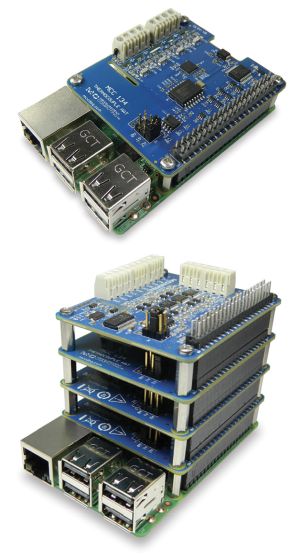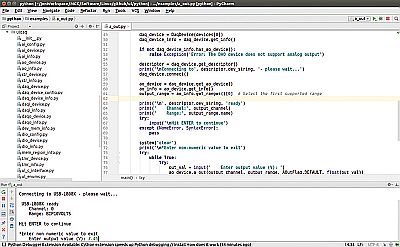Though they are more closely associated with the maker space, Raspberry Pi boards can be effective at handling stringent industrial measurements.
Steve Radecky, Measurement Computing Corp.
Originally designed to be a cheap, almost disposable computer, Raspberry Pi was created to get kids interested in programming. Since its introduction in 2012, Raspberry Pi has become the third-best-selling general-purpose computer platform, trailing only the Microsoft Windows PC and Apple Macintosh. It’s estimated that up to 44% of Raspberry Pi’s are now bought by “industrial” customers. A powerful feature set along with the Raspberry Pi community and $35 price tag have continued to fuel this tremendous growth.
The current pandemic has also helped grow the Raspberry Pi market. With more people working from home, the demand for small, inexpensive engineering projects has soared. Raspberry Pi has become a good fit for these types of applications and has made programming and engineering even more accessible.
Raspberry Pi does not have built-in test and measurement capabilities such as analog-to-digital converters (ADCs), digital-to-analog converters (DACs), or conditioned digital inputs and outputs (DIO). However, these capabilities can be added through the 40-pin GPIO header. A device that connects directly to the 40-pin header and stacks onto the Raspberry Pi is called a HAT (Hardware Attached on Top).
Over the years, individuals have published open-source designs and small companies have sold low-cost HATs for a variety of tasks, including support for analog and digital I/O. These designs and products are adequate for the education and hobbyist/maker market but have some serious short comings for professional test and measurement applications. Most of these devices are provided partially assembled, without specifications or programming support, and without performance guarantees that can only be achieved with a thorough device validation process.

MCC offers five products designed for test and measurement applications that conform to the Raspberry Pi HAT standard. These devices provide data acquisition features like analog and digital I/O in a small, stackable format.
MCC 118 is an eight-channel voltage measurement HAT. It allows users to measure 12-bit data at an overall throughput of 100 kS/sec. Eight devices can be stacked on a single Raspberry Pi to create a 64-channel device capable of reading data at a combined rate of 320 kS/sec.
MCC 128 features 16-bit resolution and includes eight analog inputs with a maximum sample rate of 100 kS/sec. Multiple gains ranges are also included which provides users the ability to make precision measurements.
MCC 152 provides two 12-bit analog outputs along with eight 5-V or 3.3-V DIO channels enabling the creation of a full multifunction Raspberry Pi measurement and control system.
MCC 134 is designed for temperature measurement applications and features four thermocouple input channels. A 24-bit A/D and cold junction compensation provide professional grade accuracy. Multiple thermocouple types are selectable on a per channel basis.
Thermocouples provide a low-cost and flexible way to measure temperature, but measuring thermocouples accurately is difficult. Nevertheless, it is now possible to measure thermocouples accurately in the uncontrolled Raspberry Pi environment.
MCC 172 is designed for sound and vibration applications and offers two IEPE input channels capable of measuring IEPE sensors like accelerometers and microphones without any additional signal conditioning. Inputs can be simultaneously sampled at up to 51.2 kS/sec per channel.
DAQ HATs can be used in basic applications with just a few voltage input channels or more sophisticated applications with up 64 channels of multiple signal types.
Up to eight MCC DAQ HATs can be stacked onto one Raspberry Pi. HATs are available with voltage inputs, thermocouple inputs, IEPE-based sensor inputs, analog outputs, and digital I/O, allowing users to configure multifunction, Raspberry Pi-based solutions.
MCC DAQ HATs come with software libraries that support Python and C/C++ to facilitate quick and easy development. Comprehensive API and hardware documentation are also provided. The DAQ HAT software library was created and is supported by MCC. The development repository is located on GitHub where users can find libraries, examples, firmware updates, and more.
Applications for Raspberry Pi DAQ
Raspberry Pi is a good fit for many DAQ applications. MCC DAQ HATs have been used in a variety of applications and industries. These applications can be lab-based, remote and IoT solutions, and 
One such customer is RO Scientific. It specializes in providing custom DAQ solutions and had a requirement for developing an automated permeameter machine. Accurate rock permeability measurements are critical for the oil and gas industry as the costly decision to drill in a particular spot heavily relies on such permeability measurements performed on prospective core samples.
RO Scientific decided on the Raspberry Pi platform because they needed something as small as possible yet capable of providing enough computational power to perform some basic machine vision, do real time data acquisition and processing, and transfer the outcome via Wi-Fi to a remote interface.

Using a hi-rez camera, the system scans the measurement table, determining the edges of the rock sample. A pneumatic actuator then lowers a probe to the sample surface and a gas is injected into the rock sample. The setup measures pressure at several points, logs temperature data, and determines gas viscosity. A fast-responding pressure sensor makes measurements at 10 kS/sec, monitoring the pressure decay. The sample permeability is calculated from this pressure decay curve, in conjunction with the other pressure and temperature measurements. This process is repeated in several locations within the sample.
The outcome was a 90% drop in the overall measurement time and the measurements proved to be as accurate as when performed by a human expert, and equally important, made the whole process repeatable.
The Probe Permeameter machine makes measurements in core samples using an X-Y control system with under one millimeter precision. A Raspberry Pi 4 board is at the heart of it, providing enough processing power for the machine vision and data acquisition and control functions.






Leave a Reply
You must be logged in to post a comment.